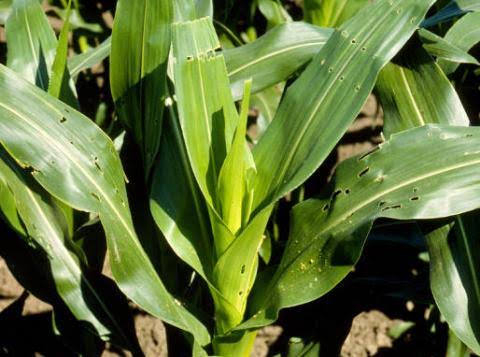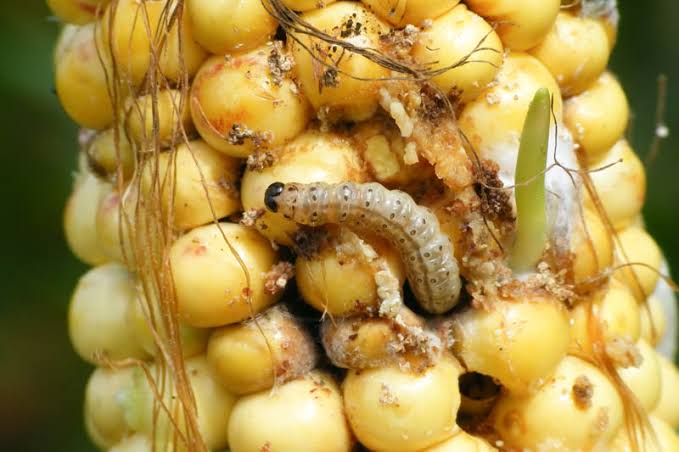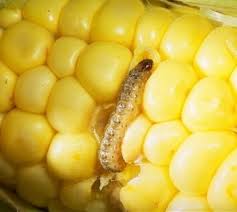The European corn borer, scientifically known as Ostrinia nubilalis, is a notable insect that affects corn crops in Europe and North America. This small moth, despite its size, has significant consequences for agriculture due to its larval stage feeding on corn plants.
The life cycle of the European corn borer begins with adult moths laying eggs on corn leaves. These eggs hatch into larvae, commonly referred to as corn borers. These larvae bore into the corn stalks, where they spend the majority of their life feeding on the inner tissues. This feeding activity can weaken the corn plant, making it susceptible to other diseases and reducing overall crop yield.
Farmers face challenges in managing European corn borer infestations, as these pests can be elusive and difficult to detect. Integrated pest management strategies, including the use of natural enemies and resistant corn varieties, are employed to mitigate the impact of these insects on corn crops.
One of the key concerns with the European corn borer is its ability to adapt to different environmental conditions. This adaptability makes it a resilient pest, capable of surviving in various climates and regions. As a result, researchers and agricultural experts continually study the biology and behavior of the European corn borer to develop more effective control measures.
In recent years, advancements in biotechnology have led to the development of genetically modified corn varieties that express proteins toxic to the European corn borer. These genetically modified crops have shown promise in reducing the impact of infestations and improving overall crop resilience. However, the adoption of such technologies is not without controversy, and ongoing debates surround the use of genetically modified organisms in agriculture.
The European corn borer, scientifically known as Ostrinia nubilalis, poses a significant threat to corn crops, impacting agricultural productivity in Europe and North America. Researchers and farmers alike continue to explore innovative strategies for managing these pests, balancing the need for effective control with environmental and ethical considerations.
Read Also: Longans: History, Nutrition, Health Benefits and Growing Guide
Plants Affected by European Corn Borer (Ostrinia nubilalis)

The primary plant affected by the European corn borer (Ostrinia nubilalis) is, as the name suggests, corn (Zea mays). Corn, also known as maize, serves as the principal host for this insect pest. The larvae of the European corn borer infest corn plants, causing damage by tunneling into the stalks and feeding on the internal tissues.
Apart from corn, European corn borers can also impact other crops and plants, albeit to a lesser extent. They have been known to infest various grasses and grassy crops, such as sorghum and millet. Additionally, certain reports suggest that European corn borers may occasionally affect other plants like peppers and tomatoes.
However, the economic significance of the European corn borer is most pronounced in corn agriculture. The adaptability of this pest to different environmental conditions makes it a persistent threat to corn crops, requiring farmers to employ effective pest management strategies to minimize the impact on crop yield and quality.
Damages Caused by European Corn Borer

The European corn borer (Ostrinia nubilalis) inflicts significant damage on corn crops, impacting both yield and quality. The primary damages caused by this insect are associated with its larvae, which bore into various parts of the corn plant. Here are key aspects of the damages caused by the European corn borer:
1. Stalk Damage: The larvae tunnel into the stalks of corn plants, creating tunnels as they feed on the inner tissues. This activity weakens the structural integrity of the stalks, making them more susceptible to lodging or breaking. Lodging can result in reduced standability of the corn plants, making harvesting more challenging and leading to yield losses.
2. Reduced Yield: The feeding activity of European corn borer larvae directly affects the yield of corn crops. Weakened stalks, decreased photosynthetic activity, and potential ear damage contribute to a decrease in overall corn production. Yield losses can be particularly significant if infestations occur during critical stages of corn development.
3. Ear Damage: European corn borer larvae may bore into the ears of corn, causing damage to the kernels. This not only reduces the quantity of marketable corn but can also affect the quality of the harvested crop. Damaged ears may be more prone to fungal infections and mycotoxin contamination.
4. Secondary Infections: The entry points created by European corn borer larvae can serve as pathways for pathogens, increasing the risk of secondary infections. Fungal and bacterial diseases may exploit the weakened plant tissues, further contributing to yield losses and compromising the overall health of the corn crop.
5. Quality Issues: In addition to reducing yield, European corn borer damage can affect the quality of harvested corn. Damaged kernels may be more susceptible to contamination, reducing the value of the crop for both human and animal consumption. Quality issues can also impact the marketability of corn products.
Efforts to manage and mitigate the damages caused by European corn borer include the use of integrated pest management strategies, genetic resistance in corn varieties, and, in some cases, the application of chemical insecticides. Continuous research and monitoring are crucial for developing effective and sustainable approaches to minimize the economic impact of this insect pest on corn agriculture.
Read Also: Pomegranates: History, Nutrition, Health Benefits and Growing Guide
Control and Preventive Measures

Farmers employ a combination of control and preventive measures to manage the impact of the European corn borer (Ostrinia nubilalis) on corn crops. These strategies aim to reduce infestations, minimize crop damage, and maintain overall agricultural productivity. Here are key control and preventive measures:
1. Biological Control: Introducing natural enemies of the European corn borer, such as parasitic wasps and predatory insects, can help control their populations. These natural predators target the larvae and eggs of the corn borer, acting as a biological control method.
2. Genetic Resistance: Planting corn varieties with genetic resistance to the European corn borer is an effective preventive measure. Some corn hybrids are bred to express proteins toxic to the corn borer larvae, providing built-in protection. This reduces the reliance on chemical insecticides and can contribute to sustainable pest management.
3. Crop Rotation: Implementing crop rotation practices disrupts the life cycle of the European corn borer. By planting non-host crops in alternate years, farmers can reduce the buildup of corn borer populations in a specific area, helping to break the cycle of infestation.
4. Timely Planting and Harvesting: Timely planting and harvesting are essential in managing European corn borer infestations. Planting corn early can help escape peak corn borer flight periods, and early harvesting can reduce the likelihood of larval damage to mature ears.
5. Pheromone Traps: Using pheromone traps in corn fields helps monitor the presence and activity of adult European corn borer moths. This information assists farmers in determining the timing of potential infestations and implementing control measures more effectively.
6. Insecticides: Chemical insecticides can be applied to control European corn borer populations. However, the use of insecticides is often considered a last resort, as it may have implications for non-target organisms and can contribute to the development of insecticide resistance. Integrated pest management approaches prioritize the judicious use of insecticides.
7. Cultural Practices: Practices such as plowing under crop residues and removing crop debris can help reduce overwintering sites for European corn borer larvae. This can be an effective cultural practice in minimizing the carryover of the pest from one season to the next.
8. Monitoring and Scouting: Regular monitoring of corn fields is crucial for early detection of European corn borer infestations. Scouting involves inspecting plants for signs of damage and assessing pest populations. Early detection allows for timely intervention and better pest management outcomes.
Adopting a holistic and integrated approach that combines various control and preventive measures is key to effectively managing European corn borer populations while promoting sustainable and environmentally friendly agricultural practices.
Frequently Asked Questions (FAQs) About European Corn Borer (Ostrinia nubilalis)
1. Q: What is the European corn borer, and why is it a concern for farmers?
A: The European corn borer (Ostrinia nubilalis) is a moth whose larvae feed on corn plants, causing damage to stalks and ears. It is a concern for farmers as it can significantly impact corn yield and quality, leading to economic losses.
2. Q: How can farmers identify the presence of European corn borer in their corn fields?
A: Farmers can monitor for European corn borer by checking for signs such as wilting, stalk breakage, and entry holes in the corn stalks. Pheromone traps can also be used to detect adult moth activity.
3. Q: What crops, besides corn, can be affected by the European corn borer?
A: While corn is the primary host, European corn borers can infest other grassy crops like sorghum and millet. Occasional infestations have been reported on plants such as peppers and tomatoes.
4. Q: Are there natural enemies of the European corn borer that can help control its population?
A: Yes, natural enemies such as parasitic wasps and predatory insects can be introduced to control European corn borer populations. Biological control is an eco-friendly approach to managing this pest.
5. Q: Are there corn varieties resistant to the European corn borer?
A: Yes, some corn hybrids are genetically resistant to the European corn borer. These varieties are engineered to express proteins toxic to the larvae, providing built-in protection against infestations.
6. Q: How can farmers reduce the risk of European corn borer infestations through cultural practices?
A: Cultural practices like crop rotation, timely planting, and harvesting, as well as the removal of crop residues, can help reduce the risk of European corn borer infestations by disrupting their life cycle.
7. Q: What is integrated pest management (IPM), and how does it relate to controlling the European corn borer?
A: Integrated pest management is an approach that combines various strategies, including biological control, genetic resistance, and judicious use of insecticides, to manage pests like the European corn borer effectively. It aims to minimize environmental impact and promote sustainable pest control.
8. Q: Are chemical insecticides the only solution for controlling European corn borer?
A: No, chemical insecticides are one of several control measures. Integrated pest management emphasizes a holistic approach, including biological control, cultural practices, and genetic resistance, to minimize reliance on chemical treatments.
9. Q: Can the use of genetically modified corn for resistance against European corn borer have any environmental implications?
A: The use of genetically modified corn has raised concerns, and ongoing research assesses its environmental impact. While it can reduce the need for chemical insecticides, potential ecological effects and public perceptions are important considerations.
10. Q: What should farmers do if they suspect a European corn borer infestation in their fields?
A: Farmers should conduct regular field scouting to detect early signs of infestation. If infestation is suspected, timely intervention measures such as introducing natural enemies, using resistant corn varieties, or employing targeted insecticides can be considered.
Read Also: Sheep 101: Wool Production Complete Guide
